Curator Ashvin E. Rajagopalan‘s path into art curation is marked by passion, dedication, and a deep interest in the intersection of history and creativity—particularly in how human sentiment is expressed through art. Rajagopalan graduated from New York’s Pratt Institute in Brooklyn, where he majored in jewelry design and developed a keen interest in art history. In 2002, he returned to his roots in Chennai, India.

Image courtesy of Ashvin E. Rajagopalan
My aim in each exhibition is to simplify the knowledge and wisdom of each curatorial topic and to present it to a completely neutral audience from all walks of life
Ashvin E. Rajagopalan
There, Rajagopalan founded Ashvita Art Objects & Artefacts, an art gallery that has since become a significant force in the Indian art. Over the past 22 years, Rajagopalan has worn many hats—gallery owner, curator, and art advisor—building a reputation for his insightful approach to curation and his expertise in guiding collectors across the globe. Eventually, he consolidated all his art-related ventures under a single brand—Ashvita‘s—in 2018.
The 2008 financial crisis shook global markets, and India was not immune to its effects. However, as they say, there is always fortune in misfortune; Rajagopalan saw the silver lining, seizing the opportunity amidst this global challenge. He began consulting for prominent business families in Mumbai, assisting them in building impressive art collections, eventually leading to the creation of the Piramal Museum of Art in 2015. Today, Rajagopalan’s art consultancy manages six significant family collections, making it the most extensive collection of Indian modern and contemporary art under management in the country.
Rajagopalan’s curatorial approach is rooted in research and driven by a desire to uncover deeper narratives within art. As the curator states, “My aim in each exhibition is to simplify the knowledge and wisdom of each curatorial topic and to present it to a completely neutral audience from all walks of life.”
Rajagopalan’s latest curatorial project is Bhakti: The Art of Krishna, an exhibition at Mumbai’s Nita Mukesh Ambani Cultural Centre (NMACC). The exhibition explores themes of love and devotion through the lens of Lord Krishna’s life and legacy, featuring 107 rarely seen works, including paintings, sculptures, and historical artefacts by fifteen iconic Indian artists, such as Raja Ravi Varma, M.F. Husain, and Manjit Bawa. In this interview, Rajagopalan discusses his curatorial process, his experiences in the art world, and the essence behind Bhakti: The Art of Krishna.
Hi Ashvin, thank you for taking the time to speak with us. Could you share your journey into the arts and how you got started with curating?
Ashvin E. Rajagopalan: I studied fine art at Pratt Institute, Brooklyn, New York. Graduated in 2002. My major was in jewellery and I had a great interest in art history. I returned to Chennai, India in 2002 soon after graduating, and started my art gallery called Ashvita Art Objects & Artefacts. Over the past 22 years, I have worked as an art gallery owner, curator, and art advisor to clients across India. In 2018 we rebranded our entire art operations under the single brand called Ashvita’s.
In 2008, with the housing market crash, the art market in India greatly suffered. At this point, I was blessed with an opportunity of consulting for a Mumbai-based business family to build their collection. This gave birth to me setting up the Piramal Museum of Art in 2015. While I continued to operate Ashvita’s we also build a consulting business for institutional family collections to build great art collections. Today, we represent 6 such family collections, amounting to the largest collection of Indian modern and contemporary art under management.
I have always been deeply interested in research-based practices and my curatorial process has followed investigative methods.
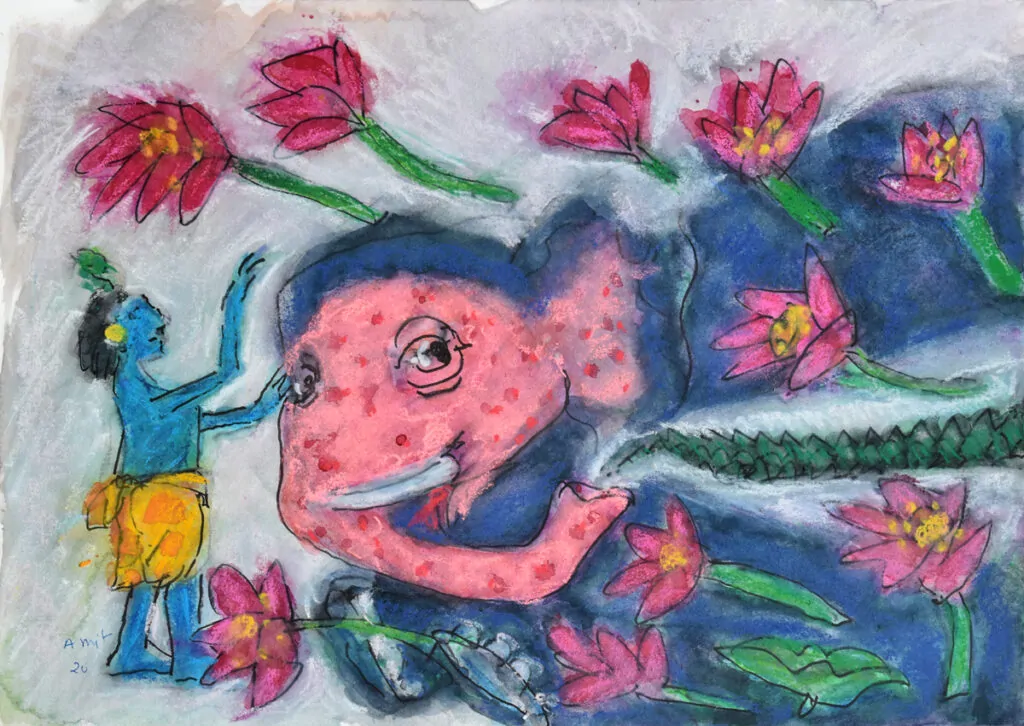
Amit Ambalal
Courtesy of Archer Gallery
Can we delve into your curatorial practice and the key aspects of your approach to exhibitions and curating?
Ashvin E. Rajagopalan: Over the years, I have curated a few significant exhibitions. These include complete retrospectives of artists like S. H. Raza & Raja Ravi Varma. I have worked on a ceramics exhibition which was the first complete survey of the history of Indian Ceramics post Independence. I have also curated a couple of exhibitions along with my co-curator Vaishnavi Ramanathan, on topics such as Fakes & Forgeries in India, Indigenous art materials before the canvas came to the subcontinent as well as educational shows on Making Art.
My aim in each exhibition is to simplify the knowledge and wisdom of each curatorial topic and to present it to a completely neutral audience from all walks of life. The show and its content has to be engaging and informative. The content and writing is always in simple and easy to understand language.
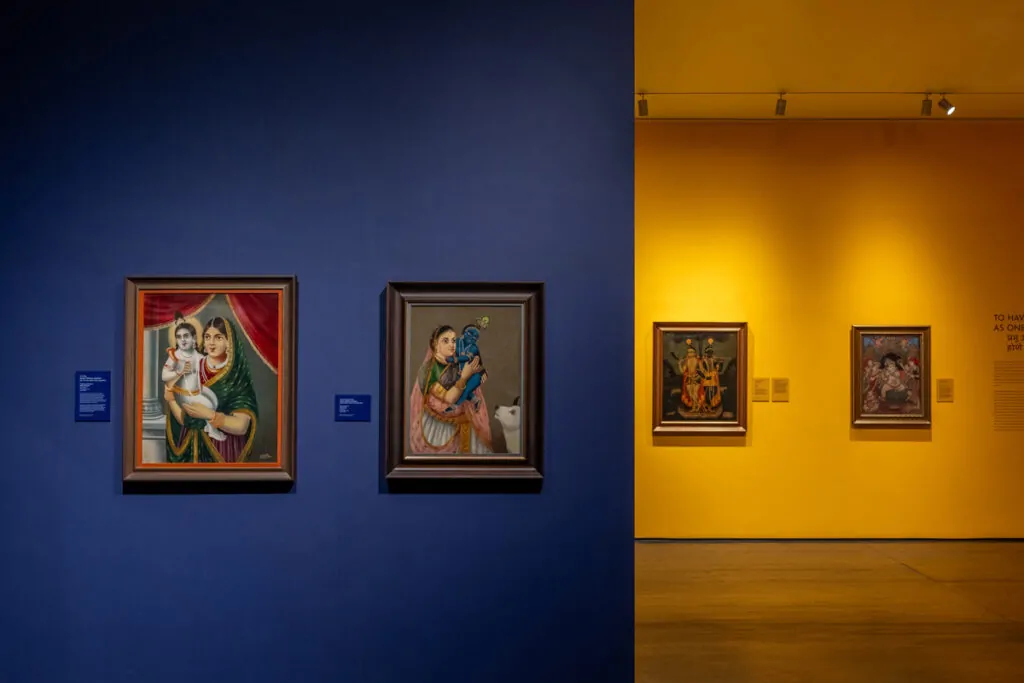
1. Courtesy of DAG, New Delhi, Mumbai, New York 2. Courtesy of DAG, New Delhi,
Mumbai, New York 3. Courtesy of Private Collection, New Delhi
4. Courtesy of Piramal Museum of Art, Mumbai
Photo Courtesy : Nita Mukesh Ambani Cultural Centre Photographer : Kuber Shah
You recently opened “Bhakti: The Art of Krishna” at Mumbai’s NMACC. The exhibition explores the theme of universal love and devotion through Lord Krishna. How did you select the specific artworks and artefacts to represent the spiritual and philosophical aspects of Krishna’s life and teachings? Were there particular challenges in balancing artistic aesthetics with the spiritual messages?
Ashvin E. Rajagopalan: When the concept of Bhakti was arrived at, there were two possible routes we could have taken. One would have been to curate a wholly object-driven exhibition where the history and importance of the object took precedence, and the other path was to tell the story of Krishna and use artworks to illustrate the narrative. We chose to go with the story. When this was the agenda, choosing artwork were more about the theme of the artwork and was agnostic to material, artist, period etc. When looked at in totality, the aesthetic, being driven by all the artist’s bhakti towards the subjects, fell into place.

Photo Courtesy : Nita Mukesh Ambani Cultural Centre
Photographer : Kuber Shah
What was your overarching vision for the exhibition, and how did you structure the narrative to guide visitors through the diverse aspects of Krishna’s life and teachings? How did you decide on the thematic flow and arrangement of the artworks?
Ashvin E. Rajagopalan: Like any institutional exhibition, the physical space must be considered to build the visitor’s experience journey. Given that the Art House which has four floors is designed to flow from one floor to the next rather than a single linear space, it was interesting to break down the concept into Birth and Life of Krishna, His teachings, and finally how we experience ‘Bhakti’ – devotion and submission
The real test was not about the subject or the story of Krishna, it was rather how the audience’s high level of knowledge over a subject of Krishna, can provide for newer dialogues and experiences through art. Unlike an artist whose presence is known to the artworld and art enthusiast’s, Krishna is known to over a billion people in detail. I have never previously engaged in curating or telling a story that is popularly known in the country. The interesting challenge was how I could take renowned artists who have depicted Krishna in their own mediums either through paintings, sculptures, immersive projections and even a board game to give it a universal interactive experience.
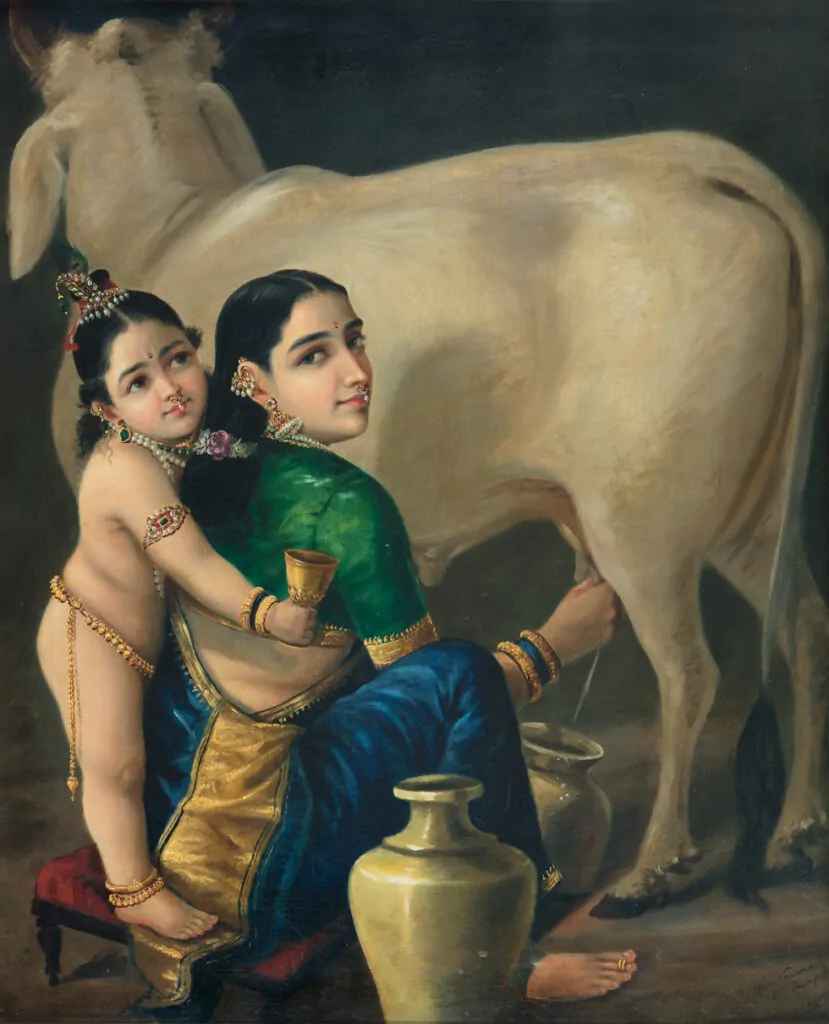
Courtesy collection of Ashish Anand, DAG
Spanning 1000 years, the exhibition includes works from diverse cultures and artists such as Raja Ravi Varma, M.F. Husain, and Manjit Bawa. How did you approach the task of curating such a wide temporal and stylistic range? What were the key criteria for including specific artists and works?
Ashvin E. Rajagopalan: As mentioned earlier, the approach was to tell the story and fit whichever artwork illustrated or highlighted those pivotal moments in Krishna’s life. The choice was more about that than who the artist is. However, some thought was put into keeping the artists well-balanced. Which is why, on one side, we have 3rd and 4th century stone and bronze sculptures some exceptional Raja Ravi Varma paintings, brand calendar prints, and new replicas of temples.
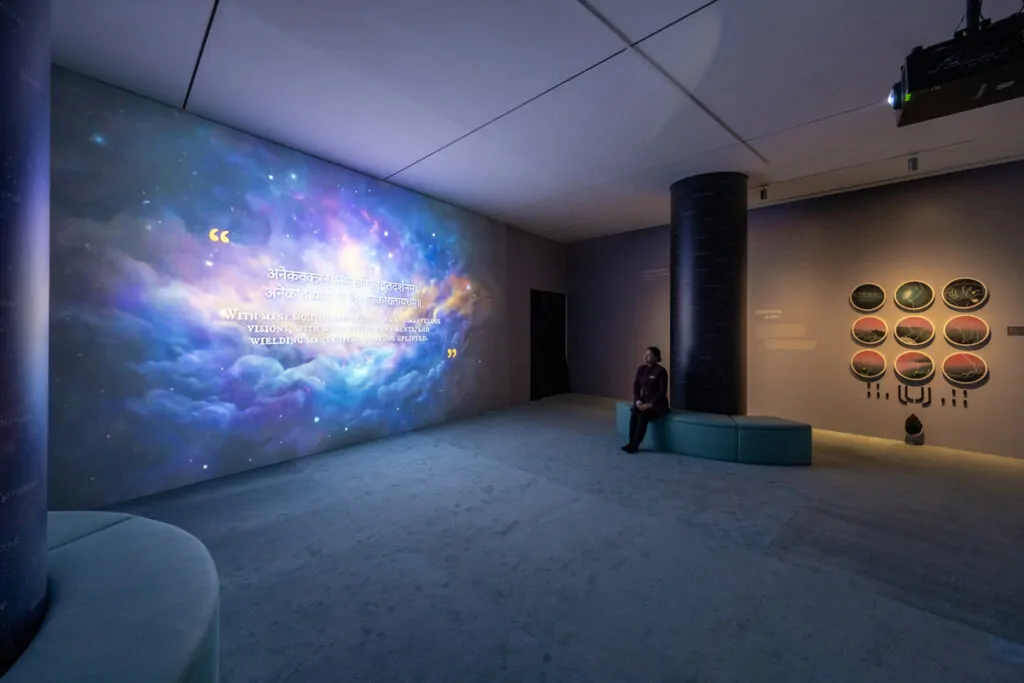
Courtesy of Piramal Museum of Art, Mumbai
Photo Courtesy : Nita Mukesh Ambani Cultural Centre Photographer : Kuber Shah
“Bhakti: The Art of Krishna” also features engaging elements like the shadowplay room, typography room, and digital projection of Vishwarupa. How do these multimedia and immersive experiences contribute to the viewer’s understanding and experience of Krishna’s teachings?
Ashvin E. Rajagopalan: The use of shadow, text and multimedia is a very interesting layer to the show. These three rooms represent Manasa, Vacha & Karmana. Meaning, the mind (thoughts) words, what is spoken and what is taught, and Karmana which is action or surrendered to the results of our action.
This concept is the very essence of the Bhagavad Gita which is Krishna’s greatest text given to us. On the battlefield, when Arjuna was unable to get up and fight his cousins and his mind was confused, Krishna spoke to him with the words of the Gita. It is these words that gave Arjuna the strength to get up and fight. Finally, he surrendered to Krishna when he saw the Lord in all his magnificence. We have tried to create this feeling of hope and resilience that Krishna gives to Arjuna through the interactive and immersive elements in this exhibition.
How did the conceptual process of integrating modern technologies with traditional art forms unfold, and did this integration involve collaboration to ensure accuracy and depth due to the exhibition’s religious nature?
Ashvin E. Rajagopalan: With the help of Isha Ambani Piramal’s vision for each exhibition in the Art House needs to be unique and cutting edge. We wanted Krishna’s story to be told in all different mediums and ways that could attract younger audiences too. We as a team were extremely excited by integrating technology with artworks ranging 1000 years.
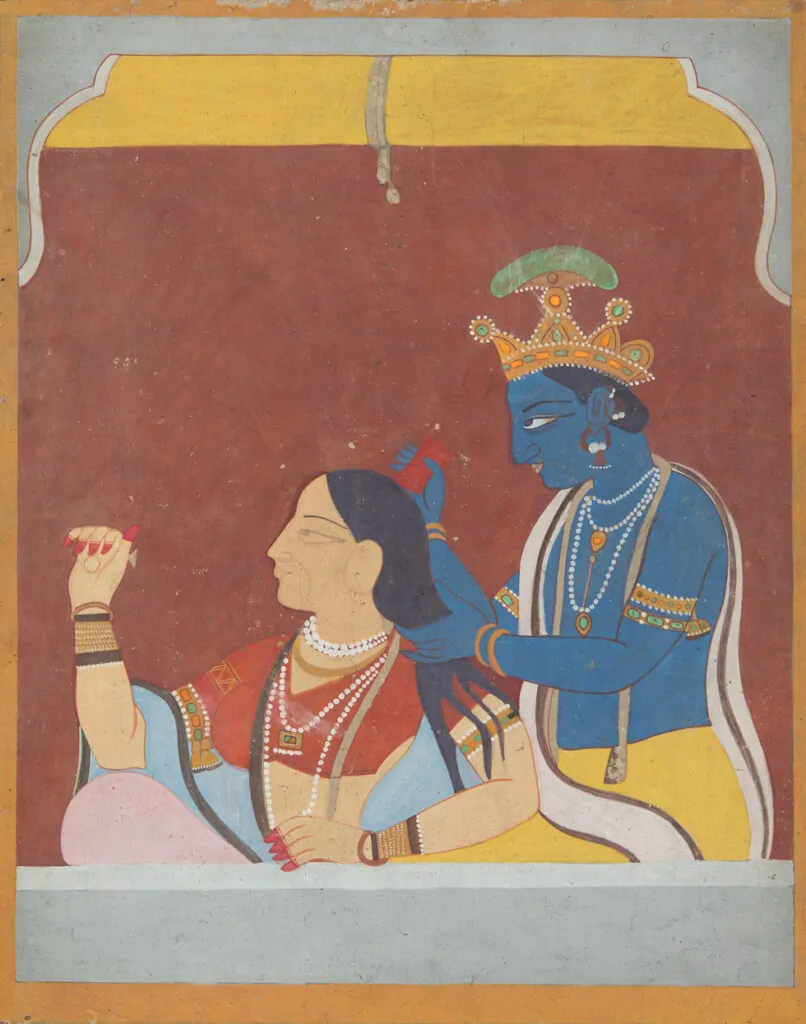
Courtesy of Delhi Art Gallery
Building on that, can we delve more into the religious context, especially the representations of different regional manifestations of Krishna, such as Rajagopalaswamy and Guruvayurappan?
Ashvin E. Rajagopalan: As part of my curatorial journey, I did not look at this exhibition with any religious slant. Bhakti and love are universal. The discovery of these themes while curating the exhibition felt very relevant in a multicultural city like Mumbai.
With regards to the various temples that were re-created; it was fascinating for me to understand how people across India have adopted Krishna into their faith systems by choosing various pivotal points in stories about the Lord. The simplicity of these stories is what makes it so appealing. My favourite one from Udupi is this: All over India, one finds Udupi restaurants famous for their Idli, Dosa and sweet sambar.
The reason why this is so, is because at the Udupi Sri Krishna temple, the system of the Math meant that many cooks were trained to cook for the pilgrims. From here some of the trained cooks commercialised this food across India. Because of the Bhakti towards Krishna, the patrons also continue to go here for these pure vegetarian experiences. It isn’t so simple either, but you know what I mean.
Similarly, each temple completely incorporates local, regional and vernacular stories into Krishna’s life which make them unique to the locality they are from. The fundamental point is that Krishna is an easily accessible and at the same time represents the absolute Truth and highest of powers.
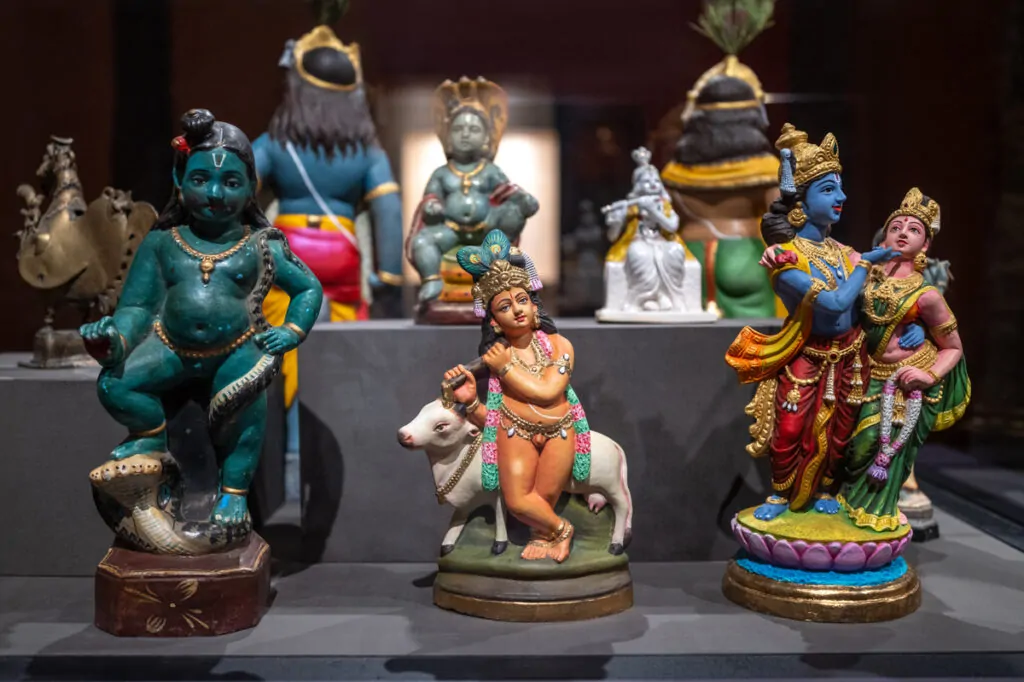
1. Krishna on Shesham by Unknown maker 2. Gopala by Unknown maker
3. Krishna & Radha by Unknown maker (middle, white)
4. Krishna by Unknown maker 5. Bala Krishna on Shesham(Krishna snake)
6. Ritual aquamanile ewer from Deccan by Unknown maker(bronze on the left)
(back, left to right) 7. Krishna by Unknown maker 8. Krishna by Unknown make
Photo Courtesy : Nita Mukesh Ambani Cultural Centre Photographer : Kuber Shah
From curation to hanging and sorting work, curators often face challenges along the way before opening. What were some of the challenges you faced during the curatorial process, particularly with respect to sourcing rare artworks and coordinating with various stakeholders?
Ashvin E. Rajagopalan: The team at the Art House in NMACC are wizards at putting together exhibitions. I had shared a wish list of ideas, lenders, and artworks and they managed to professionally and skillfully source everything for me. The entire process of production was handled by them with the help of a brilliant design firm called Culture Collective.
How do you envision the legacy of “Bhakti: The Art of Krishna” within the context of NMACC’s broader mission and the global art scene? What do you hope visitors will take away from this exhibition, and how do you see it influencing future exhibitions at the centre?
Ashvin E. Rajagopalan: NMACC’s vision is to give Indian art and culture a platform globally. I am ever grateful to them for giving me this opportunity to curate an exhibition that gave me the opportunity some of our finest Indian art and sculptures on such a universally loved subject.
We want visitors especially the younger audience to come out of this exhibition experiencing inner peace and alignment within themselves.
Bhakti: The Art of Krishna is open until the 18th of August, 2024 at The Nita Mukesh Ambani Cultural Centre (NMACC)
©2024 Ashvin E. Rajagopalan





